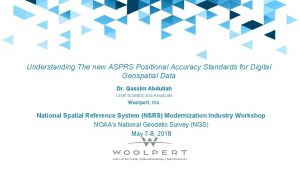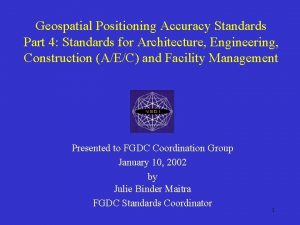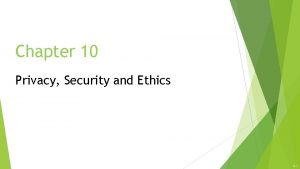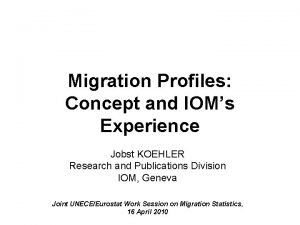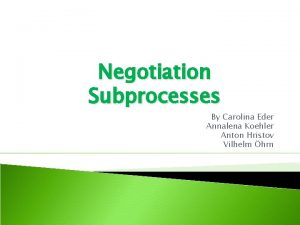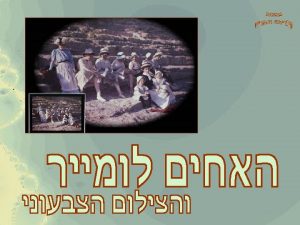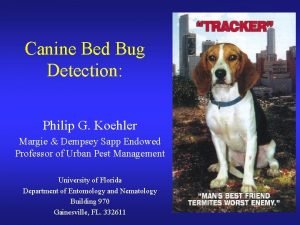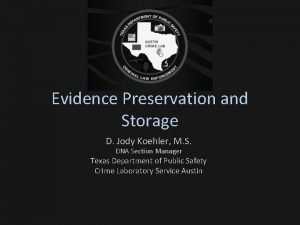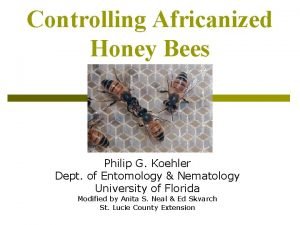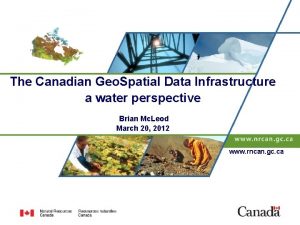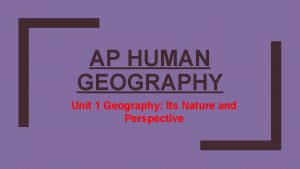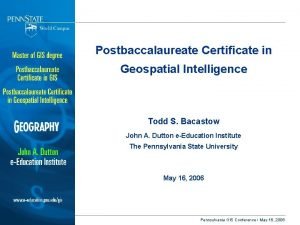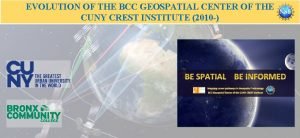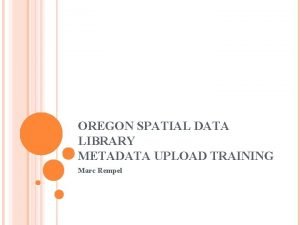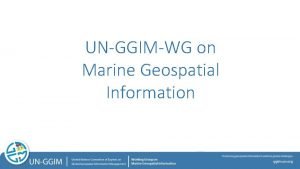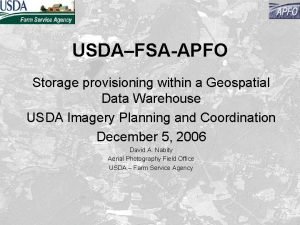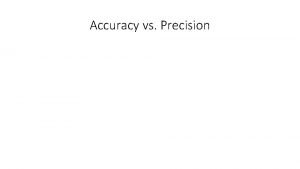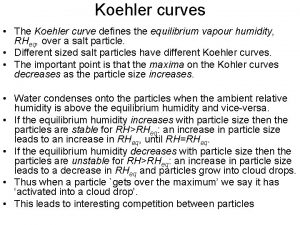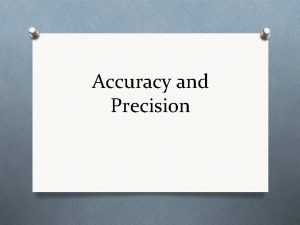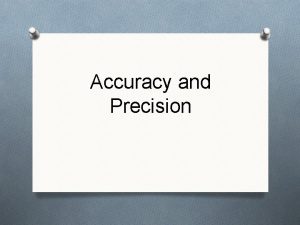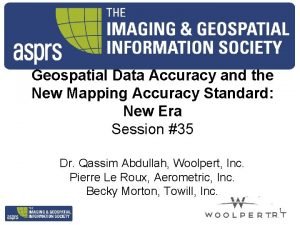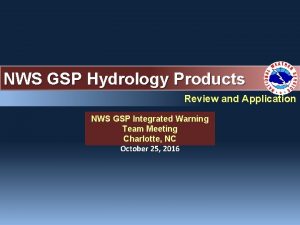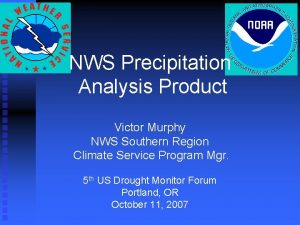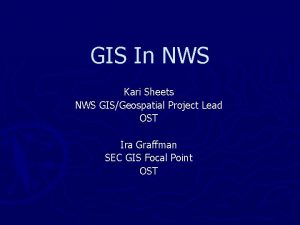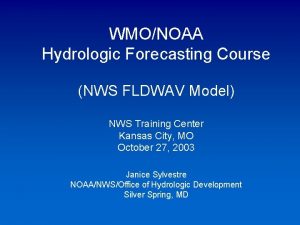NWS Geospatial Accuracy Issues NFUSE presentation Rick Koehler
























- Slides: 24

NWS Geospatial Accuracy Issues NFUSE presentation Rick Koehler, Ph. D NOAA – NWS – OCWWS – FDTB Boulder, CO April 9, 2008 richard. koehler@noaa. gov

Presentation purpose and outline Possible NFUSE discussion topic - geospatial issues ACUF White Paper (recommendations 4. 0 and 5. 0) Why even worry? “Comparison” - GPS technology and NWS product Accuracy measurements Position uncertainty RIDGE geospatial errors Geospatial experiment Reference - NSRS Estimated accuracy of NWS data Needs assessment and standards Summary April 9, 2008 NFUSE team presentation

ACUF White Paper Recommendation 4. 0: NWS should develop and maintain the ability to produce objective uncertainty information from the global to the regional scale. Geospatial data appropriate at one scale may not be appropriate at a different scale. Recommendation 5. 0: To ensure widespread use of uncertainty information, NWS should make all raw and post-processed probabilistic products easily accessible to the Enterprise at full spatial and temporal resolution. Sufficient computer and communications resources should be acquired to ensure effective access by external users and NWS personnel. To know the full, usable spatial resolution, it is critical to know the quality and accuracy of the geospatial component. April 9, 2008 NFUSE team presentation

Why even worry? “Weather is so dynamic and models are so imprecise, we don’t have to worry about location. ” Often heard comment within NWS Uniform precipitation field Highly variable precipitation field Not critical to have exact position Important to have exact position

Why even worry? Error, Accuracy, and Precision “It is now generally recognized that error, inaccuracy, and imprecision can ‘make or break’ many types of GIS projects. That is, errors left unchecked can make the results of a GIS analysis almost worthless. ” The Geographer's Craft Project - 1995 Ken Foote and Donald Huebner Department of Geography The University of Colorado at Boulder For NWS, let AWIPS = GIS http: //www. colorado. edu/geography/gcraft/notes/error_f. html

“Comparison” “ 2 miles ahead” vs “ 2 miles, ± 0. 1 miles” or “ 2 miles, ± 2. 0 miles” April 9, 2008 NFUSE team presentation

Accuracy measures Data quality categories for Spatial Data Transfer Standards (SDTS) 15 1. Attribute accuracy 2. Position accuracy Attribute 13 10 Position 3. Lineage 11 4. Logical consistency 5. Completeness 9 5 Mac. Eachren et al. Visualizing Geospatial Information Uncertainty: What We Know and What We Need to Know Cartography and Geographic Information Science, Vol. 32, No. 3, 2005, pp. 139 -160 April 9, 2008 NFUSE team presentation

Accuracy measures But what about positional error? April 9, 2008 NFUSE team presentation

Accuracy measures Uncertainty as a distance Circle error probability (CEP) - 50% chance true position within this circle Diameter root mean square ∙ 2 (2 drms) - 95% prob used by NOAA/NOS Lat/Long listed for this point. CEP 2 drms April 9, 2008 But is the object really at this exact point? 2 drms = 2. 4 CEP NFUSE team presentation

Position uncertainty Position data is probabilistic, not deterministic GPS Unit, 95% confidence level X X Scaled from a 1: 2, 000 map, 90% confidence level 15 meters at 95% conf. level = 707 m 2 circle 1, 000 meters at 90% conf. level = 3. 14 km 2 circle (2. 7 x 10 -4 mi 2) (1. 2 mi 2 or 768 acres) NOS: Total error in position will not exceed 5 meters at the 95 percent confidence level. April 9, 2008 NFUSE team presentation

Position uncertainty – “field data” Assumed location 2 drms not stated Station "Observed" 0. 587 A 0. 413 B 0. 750 C 0. 038 D High accuracy (example 1) 2 drms = 0. 10 map unit Medium accuracy (example 2) 2 drms = 0. 25 Low accuracy (example 3) 2 drrms = 0. 50 X 1 1 Y 1 2 3 4 X 1. 01 1. 03 0. 99 1. 01 Y 0. 91 1. 91 2. 95 3. 97 X 1. 14 0. 99 0. 97 Y 1. 03 2. 21 3. 10 3. 93 X 0. 97 1. 23 0. 90 0. 81 Y 1. 14 1. 88 2. 91 4. 26 E F G H 0. 195 0. 899 0. 978 0. 662 2 2 1 2 3 4 1. 97 2. 02 2. 04 2. 00 0. 94 1. 96 2. 97 4. 01 1. 88 1. 99 1. 82 1. 81 1. 09 2. 19 2. 81 3. 96 2. 04 2. 38 1. 83 2. 02 1. 89 2. 39 4. 05 I J K L 0. 979 0. 511 0. 706 0. 305 3 3 1 2 3 4 3. 06 3. 10 3. 06 2. 96 0. 92 1. 99 2. 92 4. 08 3. 05 2. 83 3. 16 3. 02 0. 74 2. 11 3. 00 4. 13 3. 31 3. 14 2. 78 3. 06 0. 73 1. 82 2. 95 3. 70 M N O P 0. 265 0. 319 0. 001 0. 046 4 4 1 2 3 4 4. 10 3. 98 4. 02 3. 99 0. 94 1. 96 3. 07 3. 95 3. 99 4. 05 3. 95 0. 96 2. 14 3. 14 4. 01 3. 57 3. 98 4. 05 3. 92 0. 82 1. 89 2. 26 4. 34 April 9, 2008 NFUSE team presentation

Position uncertainty – contour plot Assumed location Actual location (example 1) High accuracy 2 drms = 0. 10 April 9, 2008 Actual location (example 2) Medium accuracy 2 drms = 0. 25 Actual location (example 3) Low accuracy 2 drms = 0. 50 NFUSE team presentation

Position uncertainty - grids Gridded data basis = 1 km x 1 km Case 1 Case 2 Position uncertainty 2 drms = 1, 000 m Position uncertainty 2 drms = 100 m Possibility of corners at the same location! April 9, 2008 Much more likely corners correctly located NFUSE team presentation

Position uncertainty - polygons Polygon “landmarks” Polygon may be drawn larger if key locations show a larger 2 drms circle April 9, 2008 NFUSE team presentation

RIDGE geospatial errors Position accuracy check Get readout of a known point MD – DE – PA tri-state point “MDP Corner” survey mark April 9, 2008 NFUSE team presentation

RIDGE geospatial errors DE Fire. Fox 4. 1 km (2. 5 mi) displacement 2. 6 km IE 7 3. 9 km (2. 4 mi) displacement PA MD April 9, 2008 NFUSE team presentation

Geospatial experiment Multiple map datums Find the latitude and longitude of the flagpole Unit has several different “map datums” built into the software (new ones have 70+ datums) April 9, 2008 NFUSE team presentation

Geospatial experiment April 9, 2008 NFUSE team presentation

Reference - NSRS National Spatial Reference System Longitude Accurate, stable and consistent survey network, datums, map projections, GPS, detailed data NAD 83, NAVD 88 Latitude Topography Shoreline Boundaries Urban zones Roads Streams Vegetation Fed govt standard Entrusted to NOAA April 9, 2008 NFUSE team presentation

Reference - NSRS NWS data and geospatial reference frameworks Product or database Datum Earth shape Note NOAA/NOS/ National Geodetic Survey (NGS) NAD 83 GRS 80 Basis of NSRS “Gold Standard” TOR, FFW, SVR, SMW watches and warnings WGS 84 Dept of Defense system (non-NOAA system) NDFD* WGS 84 Also listed as NCEP Sphere RFC “location table” unknown “NULL” datum for 98. 7% of locations at one office AWIPS NAD 83 GRS 80 Consistent with NSRS * Meteorological models may be based upon the International Spheroid of 1924, an reference shape never used for US surveying and mapping April 9, 2008 NFUSE team presentation

Estimated accuracy of NWS data Data sources and comparisons Product Data Source Estimated Accuracy NOS/NGS survey marks Basis of NSRS geodetic level survey methods ± 1 to 2 mm or less “Gold standard” Current AWIPS background map shapefiles 1: 2, 000 maps ± 1 km or greater (NMAS) Listed to 0. 1 m precision Watches and warning areas AWIPS display unknown, probably ± 1 km NDFD unknown Unknown, precision is 0. 1 m Radar tornado signatures (2006 study) AWIPS display ± 1. 4 km mean error, 12 km max error NCEP global model (Being addressed) Multiple sources – Unknown datum, ± 1 km Based on NCEP sphere NMAS = Natl Map Accuracy Standards April 9, 2008 NFUSE team presentation

Needs assessment Geospatial questions What’s the NFUSE assumed geospatial accuracy? What are your tolerances? Unknown data accuracy – how is this handled? ? High accuracy, no forecast affects April 9, 2008 At what point does geospatial uncertainty begin to influence forecast uncertainty? Low accuracy, forecast affected NFUSE team presentation

Position accuracy standards 3. 2. 1 Spatial Accuracy is reported in ground distances at the 95% confidence level. This means that 95% of the positions will have an error with respect to true ground position that is equal to or smaller than the reported accuracy value. The reported accuracy value reflects all uncertainties, including those introduced by geodetic control coordinates, compilation, and final computation of ground coordinate values in the product. April 9, 2008 NFUSE team presentation

Summary How does geospatial uncertainty affect forecast uncertainty? Location error can affect some products (contours, polygons) Inconsistent geospatial data exists with NWS Established reference framework maintained by NOAA Existing federal standards for data accuracy Accuracy needs assessment should be considered Has this been taken into account? April 9, 2008 NFUSE team presentation
 Asprs accuracy standards for digital geospatial data
Asprs accuracy standards for digital geospatial data Geospatial positioning
Geospatial positioning Nfuse login
Nfuse login Nfuse citrix
Nfuse citrix Nfuse citrix
Nfuse citrix Three primary privacy issues are accuracy property and
Three primary privacy issues are accuracy property and Robert koehler
Robert koehler Annalena koehler
Annalena koehler Carolina eder
Carolina eder Andrée lumière
Andrée lumière Annalena koehler
Annalena koehler Dr philip koehler
Dr philip koehler Jody koehler
Jody koehler Genevieve koehler
Genevieve koehler Dr philip koehler
Dr philip koehler Presentation layer protocols
Presentation layer protocols Presentation layer design issues
Presentation layer design issues Canadian geospatial data infrastructure
Canadian geospatial data infrastructure Aggregation definition ap human geography
Aggregation definition ap human geography Remote sensing definition ap human geography
Remote sensing definition ap human geography Geospatial intelligence certificate
Geospatial intelligence certificate Bcc geospatial center of the cuny crest institute
Bcc geospatial center of the cuny crest institute Oregon geospatial data library
Oregon geospatial data library Marine geospatial ecology tools
Marine geospatial ecology tools Gdw data warehouse
Gdw data warehouse
